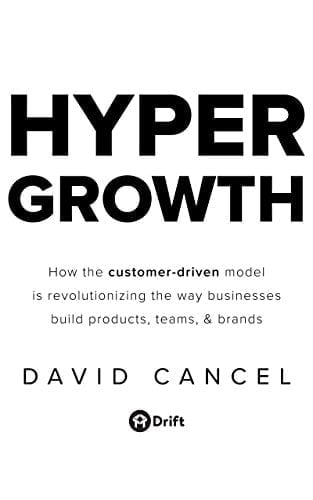Heidi Cohen Interviews David Cancel
New book: HYPERGROWTH: How the Customer-Driven Model Is Revolutionizing the Way Businesses Build Products, Teams, & Brands
 Q: What’s your best piece of advice for readers looking to improve their marketing?
Q: What’s your best piece of advice for readers looking to improve their marketing?
My best piece of advice for readers looking to improve their marketing: Never forget that every single marketing activity that you do—every blog post, every Instagram photo, every tweet, every conversation—is a reflection of your brand.
Everything you do in marketing contributes to the overall experience your customers and potential customers have with your company. So if what you’re doing in marketing isn’t making that experience better, it might not be worth doing.
Q: What was the inspiration for HYPERGROWTH?
I’ve been building software for businesses—particularly for marketing and sales teams—for my entire career. The inspiration for this book came from the realization that, across all of the companies I’ve founded over the years, my underlying focus has always been the same: The connection between businesses and their customers. It’s something I’ve been chasing for nearly 20 years, and in the book I tell the story of how it all started.
Q: What is the key concept behind HYPERGROWTH?
The key concept in my book is using a customer-driven approach to business to achieve hypergrowth. Up until my fourth company (Performable), I had been following the same playbook as everybody else. And it’s a playbook that’s largely driven by the ideas and motivations of internal stakeholders. Whether the underlying methodology is Waterfall, or Agile, the customer is noticeably missing.
At Performable, I shifted the model to make communication with customers a priority. Under this new model, everything revolves around the customer: from what features get shipped, to what words get used on the website, to how teams are structured.
For example, at Performable we came up with the idea of the three-person engineering team, with a single product manager working across multiple teams.

Having small teams, all of which communicated with customers on a daily basis, allowed us to iterate and respond to customer feedback faster than we’d ever been able to before.
Q: What do you want readers to take away from your book
I want readers to change their habits.
Because being customer-driven isn’t an empty mantra, it’s a muscle you exercise. Every company in the world will tell you they are customer-driven, but unless you actually make the structural decisions to ensure it, it’s never going to happen. Your team needs to be able to move fast enough to make changes based on product usage and customer feedback—not because something is next on a roadmap.
I have this belief that everything that we create and every idea we have is somehow wrong at first, so we need to get it out into the world as soon as possible to figure out how much of it is wrong and how we can correct it. The end goal is learning and evolving. Evolution is a hugely important part of being customer-driven.
Q: How do you describe yourself professionally?
I am a serial entrepreneur, podcast host (Seeking Wisdom) and angel investor/advisor, best-known for creating hypergrowth companies, products, and product teams at Drift, HubSpot, Performable, Ghostery, and Compete.
I’ve also been featured by media outlets such as The New York Times, Forbes, Fortune, Wired and Fast Company and I’ve guest lectured on entrepreneurship at Harvard, Harvard Business School, MIT, MIT’s Sloan School of Management, Bentley and other universities.
Q: What are 1-3 books that inspired your work/career?
- The One Thing. This is the book the aligns everything we do at Drift. Focus on the one thing. The big rocks. If you chase two rabbits, you won’t catch either.
- Ego Is The Enemy. The one thing we all fight everyday — our egos. “Success is intoxicating, yet to sustain it requires sobriety. We can’t keep learning if we think we already know everything.”
Q: What is the biggest challenge that you’ve had to overcome in your life or career?
Being able to recognize the difference between company problems and customer problems is one of the biggest challenges I’ve had to overcome. All too often companies get hung up on their own internal ideas. Instead of focusing on what customers need help with (e.g. generating more leads), they focus on what the company needs help with instead (e.g. getting people to adopt their new lead generation tool).
Once you lose sight of the core problem you’re solving, the customer experience suffers. And that’s exactly what happened with the first generation of B2B marketing software: We were focused so much on automating everything and building as much as possible, we forgot about the customer problem. And the experience. As a result, here’s what the typical B2B buyer’s journey looks like these days—It’s a mess.

Q: What’s something unusual or fun that most people don’t know about you?
As a teenager growing up in Queens in the late ’80s, my friends and I used to go to a gym called Ferrigno’s. It was named after the “Incredible Hulk” actor and body-builder, Lou Ferrigno. Turns out this gym was also a favorite of local hip-hop artists, so my friends and I often ended up working out alongside LL Cool J, and Q-Tip from A Tribe Called Quest.
Q: Is there a piece of marketing content that you’re particularly proud of?
The Hypegrowth Curve. It’s a continuation of what I started in the book and walks you through the different stages of hypergrowth.
Contact information
Thanks David.
Happy Marketing,
Heidi Cohen
UPCOMING EVENTS
MarketingProfs B2B forum is one of my favorite conferences of the year. Join me in Boston, October 3-6, 2017, for an exciting program and fun events.
Register now using my promo code: AMPLIFY1717 to save $100.

 Q:
Q: 

Comments are closed.